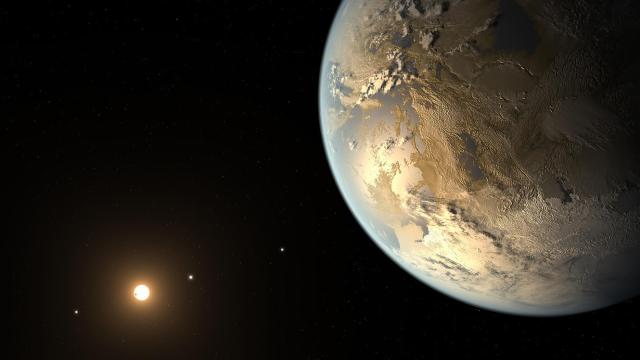Since the 1990s, astronomers have catalogued more than 3,000 exoplanets using a fairly basic detection technique known as the transit method. But what if aliens are using the same technique to spy on us? A team of astronomers is now exploring this very exciting — if not totally terrifying — possibility.
The title of the new paper, published in Monthly Notices of the Royal Astronomical Society, sums up the purpose of the study rather nicely: “Which stars can see Earth as a transiting exoplanet?” Indeed, astronomers on Earth use the transit method to spot exoplanets, so it stands to reason that alien astronomers might be using the same technique to spot us.
The transit method doesn’t allow astronomers to see an exoplanet directly. Rather, they’re seeing the temporary dimming of a distant star, in a possible sign that an exoplanet is passing in front from our perspective. These sudden drops in luminosity are very slight, but detectable nonetheless. These dimming events can yield other important data as well, allowing astronomers to determine the length of an exoplanet’s year, its temperature, and its chemical properties, the latter of which can be used to discern rocky planets from gas giants. Other detection techniques exist, such as the Doppler method, but the transit method continues to be the most reliable and straightforward.
The number of stars that we can observe through our telescopes seems almost endless, but the transit method means we’re caught in a rather glaring observational selection effect. With the transit technique, we can only spot exoplanets that pass in front of their host stars from our line of sight. Should a world be located a bit higher or lower along the ecliptic plane, well, that would mean we’re out of luck. Still, transits from our perspective happen more often than you might think, as astronomers have found thousands of exoplanets in this way.
OK, enough exposition about exoplanets and the transit method — let’s return to the new study. Cornell astronomer Lisa Kaltenegger, along with Lehigh astronomer Joshua Pepper, “reverse the viewpoint and ask from which systems other observers could see Earth as a transiting planet,” as they write in their new paper. Using data collected by NASA’s Transiting Exoplanet Survey Satellite (TESS), the scientists found 1,004 relatively nearby stars that fit into this category.
By “this category,” the authors are referring to stars in the Earth Transit Zone (ETZ), the “region from which the Earth could be seen transiting the Sun, which is a thin strip around the ecliptic as projected on to the sky with a width of 0.528°,” write the study authors.
For the researchers, it was important to exclude stars farther than around 320 light-years away. At this (relatively) close distance, alien astronomers could still detect the paltry dimming of our Sun as caused by our tiny planet passing in front.
These alien astronomers could also detect a thing or two about our pale blue dot, such Earth being a terrestrial planet, our 365-day year, and our location within our Sun’s habitable zone. We’d be an exciting catch, especially if their technology could detect biosignatures in our atmosphere, or sadly, unnaturally high concentrations of carbon dioxide — a sign of an industrial-stage civilisation. This isn’t as outlandish as you may think; the upcoming James Webb Space Telescope will be capable of collecting exactly this sort of data.
Of the 1,004 main-sequence stars listed, a disappointing 77% are red dwarfs, which are poor candidates for hosting life. Only 6% of the stars are G-types, which is the category our Sun falls into. This is an important limitation to point out, as G-type stars remain the only kind of star known to harbour life.
[referenced id=”1517333″ url=”https://gizmodo.com.au/2020/10/these-24-planets-might-be-better-places-to-live-than-earth-astrobiologists-say/” thumb=”https://gizmodo.com.au/wp-content/uploads/2020/10/08/oq3d4wwpxvcznwjh3jgj-300×168.jpg” title=”These 24 Planets Might Be Better Places to Live Than Earth, Astrobiologists Say” excerpt=”Astrobiologists have identified 24 exoplanets that aren’t just potentially habitable, they’re potentially superhabitable, exhibiting an array of conditions more suitable to life than what’s seen on Earth.”]
It’s also worth noting that, of these 1,004 stars, only three are known to have exoplanets. There’s a good chance that all of these stars have a collection of exoplanets, so the more pertinent question to ask is which of these star systems have exoplanets parked inside habitable zones. Those that apply would instantly rise to the top of the list in terms of priority targets for astrobiologists.
“If we found a planet with a vibrant biosphere, we would get curious about whether or not someone is there looking at us, too,” as Kaltenegger pointed out in the Cornell Chronicle. “If we’re looking for intelligent life in the universe, that could find us and might want to get in touch — we’ve just created the star map of where we should look first.”
Kaltenegger is very right to point this out as a possibility, though the odds are astronomically high of this actually being the case.
If true, however, we could then go about trying to communicate with this intelligent civilisation. After the initial meet-and-greet, we could get all nerdy and ask, “Hey, what brings you to the same Earth Transit Zone?” They’d laugh, and we’d be off to a fantastic start. Or they’d get super annoyed by the joke, and launch a devastating attack of killer Von Neumann probes. Those are basically the only two scenarios as I see it, and you’re welcome to debate me in comments.
